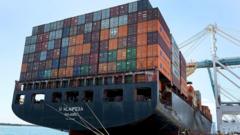As President Trump imposes new tariffs, the EU sets the stage for countermeasures, focusing on strategic economic impacts.
**European Union Prepares Retaliatory Measures Against U.S. Tariffs**

**European Union Prepares Retaliatory Measures Against U.S. Tariffs**
EU leaders finalize a counter-strategy in response to U.S. tariff announcements, navigating challenges in trade relations.
With the recent declaration by President Trump to enact a 20% tariff on goods imported from the European Union, tensions between the U.S. and the 27-nation bloc have escalated into what many fear is a brewing trade war. This week, the European Union is poised to unveil its first counteroffensive, a measured response to the U.S.'s aggressive trade policy.
EU officials have meticulously curated a list of retaliatory tariffs that is expected to be presented and voted on during their meetings in Luxembourg this week, with a formal rollout scheduled for April 15. The countermeasures are directly in reaction to the steel and aluminum tariffs that have already been imposed by the United States, with the preliminary list encompassing a wide array of products, from whiskey and bikes to boats and agricultural commodities like soybeans.
This is only the beginning of a potential series of responses, particularly with further tariffs on the auto sector looming, as announced by President Trump in late March. Notably, the strategy of rolling out responses in stages provides the EU with time to assess the ramifications of U.S. policies while crafting countermeasures that aim to maximize economic pressure on the U.S. while shield European consumers and businesses from excessive negative impacts.
Such careful consideration reflects a larger strategic goal: to address potential vulnerabilities while asserting European interests in the face of unilateral trade actions from Washington. As discussions continue, European leaders are leveraging their collective strength to navigate these turbulent economic waters.
EU officials have meticulously curated a list of retaliatory tariffs that is expected to be presented and voted on during their meetings in Luxembourg this week, with a formal rollout scheduled for April 15. The countermeasures are directly in reaction to the steel and aluminum tariffs that have already been imposed by the United States, with the preliminary list encompassing a wide array of products, from whiskey and bikes to boats and agricultural commodities like soybeans.
This is only the beginning of a potential series of responses, particularly with further tariffs on the auto sector looming, as announced by President Trump in late March. Notably, the strategy of rolling out responses in stages provides the EU with time to assess the ramifications of U.S. policies while crafting countermeasures that aim to maximize economic pressure on the U.S. while shield European consumers and businesses from excessive negative impacts.
Such careful consideration reflects a larger strategic goal: to address potential vulnerabilities while asserting European interests in the face of unilateral trade actions from Washington. As discussions continue, European leaders are leveraging their collective strength to navigate these turbulent economic waters.





















